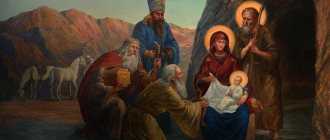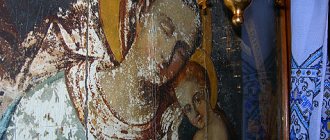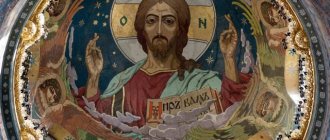Jesus Christ in appearance
Jesus Christ in appearance
on the basis of ancient church-historical and literary data. – The face of the God-man, more than any other historical figure, had the right and reason to count on artistic reproduction and preservation in Christian society. All of Judea and Galilee saw I. Christ, listened to His speeches and easily, of course, could retain in their memory the appearance of their divine Teacher. But the Gospels do not tell us a word about the appearance of the Savior; they do not even give us the most general idea of the features and character of His face. True, some of the researchers of St. The scriptures found an indication of the beauty of Christ’s appearance in the famous words of a woman: Blessed is the womb that bore you, and the breast that pissed you (Luke 11:27), but this is a very artificial conclusion, and besides, it does not give anything visual representation of the face of Christ. No such information has been preserved from the first times of Christianity. Church sources, speaking about Christ, always have in mind His moral side, His significance as a divine person, and, forgetting about appearance, they see in Him the exponent of the spiritual perfections of human nature. This ideal image is portrayed to Christians by the apostles, apostolic men, apologists and other ancient Christian writers. This is the sense in which An. Paul had the right to write to the Galatians that the image of the crucified Christ was written before their eyes (Gal. 3:1), although they did not see Christ with their own eyes. In the field of Christian art, the image of the Crucified appeared only four to five centuries after this event, and was late compared to images of other events in His life, meanwhile An. Paul uses an expression of this kind in Gal. From these and similar sources, since they are of a theological nature, of course, nothing can be deduced either for or against the existence of images of Christ at this time and one way or another can decide the question of their portraiture or conventionality. The latter's decision had to belong to practice and undoubtedly came from the environment or circle where. the idea of the appearance of Christ was guided not by abstract theological considerations, but by memories of His face, traditions from people close to Him in time, where in the simplicity of their souls they wanted to have an image of Jesus Christ, just as everyone wants to have a portrait of someone dear to him or for some reason remarkable faces. And there is no reason to doubt the existence of images of the Savior from the very first centuries of Christianity. According to St. Irenaeus of Lyon, the Gnostics, and mainly the Carpocratians among them, had some of them painted. images made partly from another material (imagines depictas et de reliqua materia fabricatas). and they traced their beginning back to the time of Christ Himself, pointing to His authentic image, allegedly executed by order of Pilate during the Savior’s earthly life; they decorated them with wreaths, placed them together with images of philosophers: Pythagoras, Plato, Aristotle and others and showed them signs of religious respect, like the pagans (Prot. of heresies 1, 25 according to Russian translation by Father P. A. Preobrazhensky in Monuments of Ancient Christian writing, Moscow 1868, p.105). Epiphanius of Cyprus, borrowing the story from Irenaeus, explains it in the sense that some of the images of the Carpocrats were painted with paints (εἰκο'νας εὐζωγραφους χρωμα'των), others were made of gold, silver and other substances (ἐκ χπυσ οῦ καὶ ἀργυ'που καὶ λοιπὴς ὑ'λης); that the named heretics performed their sacraments and sacrifices before them (heres. 20, 6). From Syria and Egypt, these main centers of Gnosticism, products and partly figurines of the Gnostics moved to the West, and a writer known by the name of Augustine (De haeresibus, cap. 7; ed. Oeler, Corp. haer. I, 198), says that a certain woman from the Carpocratian sect, named Marcellina, who arrived in Rome, according to the testimony of Irenaeus, under Pope Anicetus (157–168), worshiped images of I. Christ, Apostle. Paul, Homer and Pythagoras. Lampridius, the biography of Alexander Severus (222–235), reports that in his home shrine “(un larario suo) this emperor, along with images of gods, mythological figures: Apollonius and Orpheus and his ancestors, also had images of Christ and Abraham, giving They receive religious veneration in the morning hours (Vita Alex. Sever., cap. 29). All this shows that there was a folk tradition about the preservation of the real image of I. Christ, and under this name, both among Christians and among pagans, quite a few such images passed from hand to hand in the first centuries: there was apparently a great demand for them and correspondingly significant preparation. Constance, sister of Constantine Vel., asking Eusebius, Bishop of Caesarea, to get her an image of Christ, was guided by the same immediate desire as other pious people who wanted to find and have the true image of the Savior at all costs. Having sharply condemned the completely natural desire of Constantius, Eusebius, however, both in a letter to her (E. v. Dobschütz, Christusbilder I, S.101–102 app.), and in his church history (7.18:4; Russian. transl. pp. 424–425) states the existence in the then pagan life of the custom of depicting persons remarkable in one respect or another for home use, so to speak, and the presence among Christians of his time of picturesque images of the Apostles Peter and Paul and Christ Himself.
Another question entirely: to what extent did the images of I. Christ circulated among heretics, pagans and Orthodox Christians correspond to reality and reproduce the true features of the face of Christ? This question can rightfully be answered in the negative • 64 and already from the very first times of Christianity, the thread by which one could reach such a genuine image and say: this one of the surviving examples is the true image of Christ is lost; in such and such news we are talking about an image that has all the advantages of authenticity. Instead of such definite indications, we have several successively developing artistic types of the face of Christ and a whole series of historical evidence about the absence of such a reliable image. The fact is that already from the second century, from the times closest to the legends about the life and work of the Savior, a dispute arose in church literature about the nature of the face of Christ - a dispute that boiled down to the following simple question: what was Christ like in appearance - handsome or plain? Interpreting from a dogmatic point of view, guided by abstract theological considerations, the latter was then decided in different ways. Some of the teachers of the church, based on the idea of \u200b\u200bhumiliation accepted by the Redeemer, relying on the words of the prophet. Isaiah: There is no form for him lower than glory: and we have seen him, and there is no name for form or kindness, but his form is dishonorable, he diminishes more than all the sons of men (Is. 53: 2-3; cf. Is. 52: 14) and based on a literal understanding of the words of Ap. Paul: He humbled himself and took on the form of a servant (Phil. 2:7–8), they expressed the idea that Jesus Christ had not only an unpresentable, but positively ugly appearance. This opinion persisted for the first three or four centuries and had on its side prominent representatives of theological thought of that time. Justin Martyr in a Conversation with Tryphon (§§ 85. 88. 100; Russian translation in Memory, other Christian letters in †Fr. P. A. Preobrazhensky, vol. III, Moscow 1862, pp. 288–296. 312; [cf. also §§ 15. 49. 110. 121]) repeatedly says that Christ deigned to become a man without form and glory, appeared, according to the Scriptures, without beauty and, when he came to the Jordan, “was taken for a carpenter " Having spoken about the divine origin of the Savior, Irenaeus notes that He was ugly, subject to suffering (indecorus et passiblis) and despised by the people (Prot. of Heresies 3, 19 Russian translation, Moscow 1868, p. 372; St. Petersburg 1900, p. 293 ). “If the flesh is something slavish, as St. Paul, who would decorate a slave like a slave seller? - asks Clement of Alexandria. - And that the Lord himself did not look beautiful at all, the Holy Spirit speaks about this through the lips of the prophet. Isaiah”... (Paedag. III, cap. 1; Russian translation by NH Korsunsky, Yaroslavl 1890, pp. 244–245). The Lord “took upon himself a body that was inconspicuous and despicable,” according to Clement al., “because he feared that the beauty of His appearance would distract the attention of the listeners from His teaching; The true beauty of the Son of God lay, according to him, not in the beautiful flesh that appears to the eye, but in His soul and spiritual perfections (Stromat. II, cap. 5; III, cap. 17; VI, cap. 17; Russian translation †N. N. Korsunsky pp. 193. 195. 382. 767). Tertullian expressed himself in the same sense (Advers. Marc. 3, 17; Adv. Judaeos p. 14), and Cyril of Alexandria had already gone to the extreme and argued that the Son of God took the form of the ugliest of people. That such an opinion, despite its paradoxical nature, was quite widespread can be seen partly from the fact that Celsus, in his reproaches to Christianity, did not find it difficult to express, as a generally accepted position, that Christ had a nondescript appearance. Pointing out the discrepancy between His moral virtues, about which His followers speak, and the physical imperfections, in which they also agree, Celsus remarks: “If the Divine Spirit dwelt in Christ, then he should have been superior in appearance to all other people, but you yourself admit that He was short in stature and ugly in face” (Origen. Contra Celsura 6, 74). Other fathers and teachers of the church: Gregory of Nyssa, Augustine, Ambrose of Milan, who did not share such a narrow literal understanding of the prophetic and apostolic expressions about the humiliation of Christ, held the opposite view and considered the God-Man a representative of perfect beauty. “If He did not have something heavenly in his face and gaze,” wrote (Ep. 65 ad Principiam) Blessed. Jerome, “The Apostles would never have followed Him immediately.” And in another place: “Truly the radiance and greatness of the hidden Divinity, which was reflected in His human face, could attract them to it at the first glance at Him” (original words from E. v. Dobschütz, Christusbilder I, 107 app.). “Not only when he performed miracles was He worthy of wonder,” John Chrysostom writes about Christ, “but also when they saw Him, He was filled with great grace. Proclaiming this, the prophet sings: he is more beautiful in kindness than the sons of men (Ps. 44:3). If Isaiah speaks of Christ: without the name of appearance or kindness, then he meant what happened during His suffering, the reproach that He suffered while hanging on the cross, the humiliation that He endured everywhere throughout His entire life. life" (“Addition to the works of the Holy Father,” part 38, pp. 254–255 [and in full see The Works of St. John the Golden. in Russian translation V, St. Petersburg 1899, pp. 186–187 : Discourse on Ps.44, § 2]).
With greater severity of dogmatic concepts about the face of Christ and their gradual understanding, these two opinions about His appearance, different to the point of opposition, received a slightly different formulation and joined the teaching about the dual state of the Savior: the state of humiliation and the state of His glorification. Origen expressed a very original view of the appearance of Christ, and at the same time, as if reconciling previous contradictions, the view that the superiority of the body of Christ - in comparison with the bodies of other people - consisted in the fact that He appeared to everyone who looked at Him as required by the inner the condition and welfare of everyone. And one should not be surprised if matter, changeable and unstable by nature, took on such forms and properties by the will of the Creator that one could say about Christ: He has neither form nor goodness, and sometimes became glorious, so amazing and worthy of wonder. that the three Apostles who were on the mountain with Jesus fell on their faces from His greatness and beauty (Contra Celsum 6, 77). When applied to the images of I. Christ, Origen’s reasoning, like all the above speeches of church writers, will mean that these images did not enjoy great faith among the latter, did not have the power of any authorized model in their eyes, and were different. The variety depended on how this or that artist approached the matter, what task he set for himself and in what state or at what moment he wanted to depict Christ. Here a wide area of subjectivity opened up, and bliss. Augustine makes it clear (De trinitate 8, 4) that in his time there was no firmly established iconographic type of the Savior, and everyone depicted Him in their own way, guided by personal considerations. “The face of the incarnate Lord, which at every time (-whatever it was-) was one, is depicted differently according to the differences in countless forms of understanding” (dominicae facies carnis innnmerabilium cogitationum diversitate variatur et fingitur). A similar thought, much later, was expressed, according to the testimony of patr. Photius (Epist. 64), and the iconoclasts to the defenders of icon veneration, reproachfully asking them: “Which of the images of Christ is true: the one that the Romans, Hellenes, Egyptians have, or the one painted by the Indians? They are not all alike” (E. v. Dobschütz, Christnsbilder I, S. 107 app.).
How can we explain the absence or very early disappearance of the true image of Christ? How could it happen that the leading Christians did not make efforts, with the help of art, to consolidate and preserve in the memory of posterity the dear features of their Teacher, and those closest to the era of Christ so soon forgot His appearance? Both could depend on many reasons. Let us note those that seem most likely, explaining at the same time in what sense the matter must be understood when we are talking about the disappearance of the original image of Jesus Christ, about the oblivion of His appearance. It is difficult to admit that the thought of an artistic depiction of the Son of God could arise in the minds of the Jews who believed in Christ, for whom the former religion’s strict commandment: Thou shalt not make unto thee an idol or any likeness (Ex. 20:4. Deut. 5:8) forbade the representation of the deity in any way. in any sensual way. The centuries-old aversion from any image and the old fears of idolatry could not quickly pass in their souls and be replaced, with all their reverence for Christ, by the need to reproduce His face with paints or a chisel. Even if we were to assume such a desire among Jewish Christians, no matter how doubtful its possibility may seem to us, it would hardly be among them that there would be an artist who would be able to realize it. Our speeches take a completely different turn in relation to pagan Christians, who usually worshiped their gods in statues and sculptures, and from childhood were accustomed to seeing various kinds of images of certain wonderful people in their home environment. Here, fears of idolatry, if they existed after the adoption of a new spiritual religion, were at least not to the same extent as among converts from Judaism. Among pagan Christians, the desire to portray in one way or another I. Christ, the Son of God, could have appeared more quickly and, apparently, more easily been realized. But could their attempts of this kind have been crowned with complete success? What was portrait art at that time and what was its position then? Presenting the current strict requirements, it will be necessary to say that in general it was a weak semblance of the art with which we are currently familiar from exact photographic copies. In most cases, it did not rise to the flawless rendering of the original, and the most that it achieved was generic, tribal typicality, expressed in national facial features, in a certain cut of clothing, in a certain manner of posing the figure and in general in the treatment of the pre-personal, with almost all the individual and random eluded the artist’s attention and there could be no talk of the concrete • 65. Even if the last requirement was met in the original image, when it was repeated in photographs, the individual features were gradually smoothed out and only the largest distinctive features remained. Now, strictly speaking, we do not have portraits of either Constantine the Great or Chrysostom, despite the fact that these were extremely popular figures: their images were very common and were placed on various monuments. The bust of the Equal-to-the-Apostles Emperor on coins can rather be considered a conventional photograph of his face than a portrait: the Roman type of face, the official costume then accepted, the known attributes of royal power are retained - and nothing more. It is very difficult to single out this last one from the multitude of homogeneous numismatic figures, and the decisive importance belongs to the inscription and other conventional features. Varrov's biographies of famous Romans, compiled by him, supplied them with portraits. It cannot be said that they are distinguished by portraiture. So with regard to the image of I. Christ, there was a complete possibility of such depersonalization even with the existence of a relatively close, historically accurate photograph of His face. This is approximately the same story that was repeated, much later, in Russian iconography, where saints of the same face were painted on the same face, not excluding some of their own, from whom the images were made during their lifetime.
The church-historical and literary data to which we referred above also do not speak against the existence of ancient legends about the appearance of Christ. The disagreements between the fathers and teachers of the church in their judgments about the face of the Savior did not arise from various legends about His appearance, because it is impossible to imagine traditions so contrary, but owed their origin to considerations of an abstract dogmatic nature and corresponded to the state and nature of the then biblical interpretation. The negative side of the question, of course, did not imagine the God-man re ipsa as ugly, but had in mind the biblical idea of the Messiah, His spiritual appearance, to which it also adapted its idea of His appearance. In exactly the same way, the positive side judged the latter, guided by the views of an ideal quality. Speaking about the beauty of the Savior based on individual expressions of St. Scripture and exceptional facts from his life, the fathers and teachers of the church understood not ordinary natural beauty, but inner, unearthly beauty, shining through in his gaze, in all the features of His face. In Origen, according to whom Christ appeared to everyone according to his spiritual disposition, we see not the historical Christ, not the object of external image, but a certain kind of moral character, an ideal type, presented more or less successfully, judging by the degree of spiritual receptivity of a person. Yes, representatives of spiritual thought of that time, like the closest disciples of the Savior, deeply imbued with faith in His divine personality, were somehow indifferent to the external side, to His human appearance. As an object of sensory perception, Christ was distant or seemingly different for them; Between Him, as a historical image, and the consciousness of the theologians there stood, if I may put it this way, a fog of philosophical speculation, through which the true features of Jesus’ face came through in an unclear form, and, on the contrary, His ideal image or symbolic Christ stood out. The authentic images of I. Christ had a more base, so to speak, origin. were based on vague memories of His appearance, were associated with various kinds of legends and revolved mainly among the people; but, unfortunately, they had no future and did not have a noticeable influence on the formation and development of the iconographic type of Christ. They somehow got lost, giving way to more accepted images of the Savior, which have come down to us on catacomb monuments and in all subsequent works of church art.
A. Golubtsov.
My conclusions:
Originally Answered: What did Jesus really look like? We can say that he looked like an ordinary Jew, an average one. And there was no beauty in him, as people are accustomed to believe today.
The Son of God did not wear long hair and did not cut his temples, as required by the Law.
And the main idea is that of all the books of the New Testament, we will not find anywhere a description of what Jesus looked like, but we read what God said and did on earth. How He died on the cross and how He rose again!
15 For in Christ Jesus neither circumcision nor uncircumcision means anything, but a new creation. (Gal.6:15)
Study
Several years ago, British scientists and Israeli archaeologists decided to join forces: using forensic methods, they tried to recreate the face of Jesus Christ. This research falls under the broader field of paleoanthropology, although this particular study combines methods from many other fields along with criminology and archaeology. Scholars have taken into account aspects such as food, housing, and social life in first-century AD Judea.
Complex Covid develops less frequently today due to Neanderthal genes
Results of the last decade in the scientific world: 8 innovative inventions
Poland will allow vaccinated tourists to enter only from approved countries










